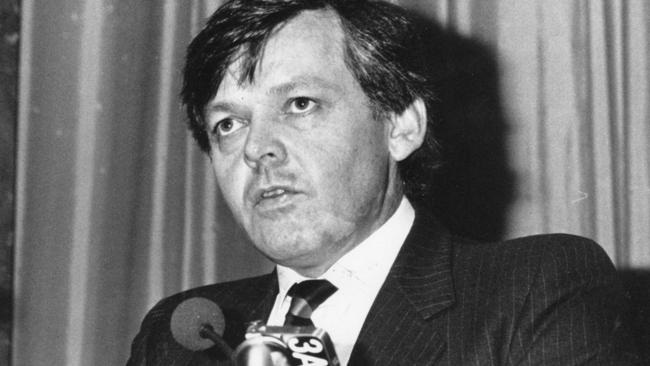Cabinet papers 1992-1993: Treasurer John Dawkins considered delay on compulsory super
In early 1992, Keating government seriously debated the deferral of the implementation of compulsory superannuation.

With the Australian economy in a serious recession in early 1992, a Federal Cabinet committee of the Keating government seriously debated the deferral of the implementation of compulsory superannuation system set for July that year.
The historic introduction of a compulsory superannuation system for Australia was announced by the Hawke Government by Treasurer John Kerin in the Budget of August 1991.
The compulsory superannuation levy on employers of three per cent of wages — and five per cent for big employers — was to apply from July 1, 1992.
Before that some employees benefited from employer provided schemes while the ACTU had won the right for superannuation to be included in industrial awards.
But many Australians still had no superannuation coverage.
Paul Keating successfully challenged Bob Hawke for the Prime Ministership in December 1991, but by early 1992 there was increasing concern among employers and the government of the cost of the move on the weakening economy.
As Prime Minister Keating prepared to make an Economic Statement to the nation, the Cabinet papers released today (Jan 1) show an ad hoc committee of Cabinet met on February 12, 1992 to consider a proposal to defer the start of the levy for six months until January 1, 1993.
The new Treasurer, John Dawkins, strongly supported the idea of a deferral, backed by representatives of the department of Prime Minister and Cabinet and Finance.
In his submission to the subcommittee meeting, Treasurer Dawkins said the introduction of the SG levy was estimated to increase labour costs by about 1.4 per cent in 1992-1993.
“Many employers see the SGL as imposing a net increase in their operating costs during the current recession,” he said.
“As the economic downturn is now more pronounced and the expected recovery later than forecast at Budget-time, there is a case for deferring the implementation of the SGL for six months,” he said.
Treasurer Dawkins said delaying the start of the SGL would lower the labour cost impact during the year “with a consequent beneficial impact on inflation and employment.”
Dawkins argued that employers and state governments were likely to support a deferral of the levy as it delayed the labour cost impact of the new levy and gave them more time to comply with the new system.
But Dawkins noted in his submission that the ACTU strongly supported the introduction of the SGL from July 1 as it saw it as providing an extension of superannuation to workers not already covered by their employer’s super schemes.
“The ACTU also sees the SGL as providing legislative protection against any future dismantling of the award super system,” he noted.
Dawkins estimated that delaying the start of the SGL would reduce costs in the 1992-93 budget by $4.5 million.
He wanted Prime Minister Keating to announce the delay of the start of the system in his economic statement planned for later in the month.
The papers show that the Department of Industrial Relations also “acknowledges the advantages of deferring the SGL” and recommended that the deferral should be “vigorously pursued with the ACTU.”
The strongest opposition to the deferral came from the Department of Social Security which said that any delay of compulsory super could lead to a push by the ACTU for higher wages to compensate.
“Deferral of the SGL might increase direct wages pressures,” it said in its position paper for the meeting.
It also warned that a deferral of the start of the SGL “might threaten its ultimate implementation, threatening achievement of the government’s retirement income objectives.”
Despite the Treasurer’s recommendations, the committee ultimately decided not to defer the start of the SGL, paving the way for its implementation from July 1 that year.
The papers do not reveal the debates which led to the decision to go against Treasurer Dawkins’ recommendation.
The Cabinet papers also show that Cabinet in January was looking at a range of moves which could be included in the February Economic Statement including the possible access of superannuation fund money for housing loans.
A proposal to the Cabinet meeting of January 28, 1992 included examining “options for greater use of superannuation savings for housing finance by allowing super funds to lend to members on concessional or commercial terms.”
But, like the proposed deferral of the SGL, it did not go ahead.
The Cabinet papers also reveal a debate within government on the tax concessions around superannuation which would apply once the SGL scheme started on July 1, 1992.
A Cabinet meeting of June 9 debated what to do with the range of tax concessions then in place for individual superannuation contributions.
It agreed that the current deduction and rebate arrangements for employees who had employer super support be dropped when the SGL was implemented.
In a hint of things to come, the Department of Prime Minister and Cabinet raised the issue of potentially increasing the tax on super fund earnings.
“In our view, a sustainable system will require an increase in the present tax rate on funds’ earnings and employer contributions,” PM and C said in its recommendations for the Cabinet meeting.
“Our preferred option would be to increase the tax rate from 15 to 20 per cent.”
The tax rate on earnings of super funds in the accumulation phase remains at 15 per cent to this day while the 15 per cent tax rate on super contributions was doubled to 30 per cent for people earning more than $300,000 a year by the last Labor Government.
The Turnbull government is planning to further increase the tax on super contributions for upper income earners, expanding the 30 per cent tax rate on contributions to start for people earning at least $250,000 a year from July 1, 2017.
The National Archives of Australia today released selected key Cabinet records for 1992 and 1993








To join the conversation, please log in. Don't have an account? Register
Join the conversation, you are commenting as Logout